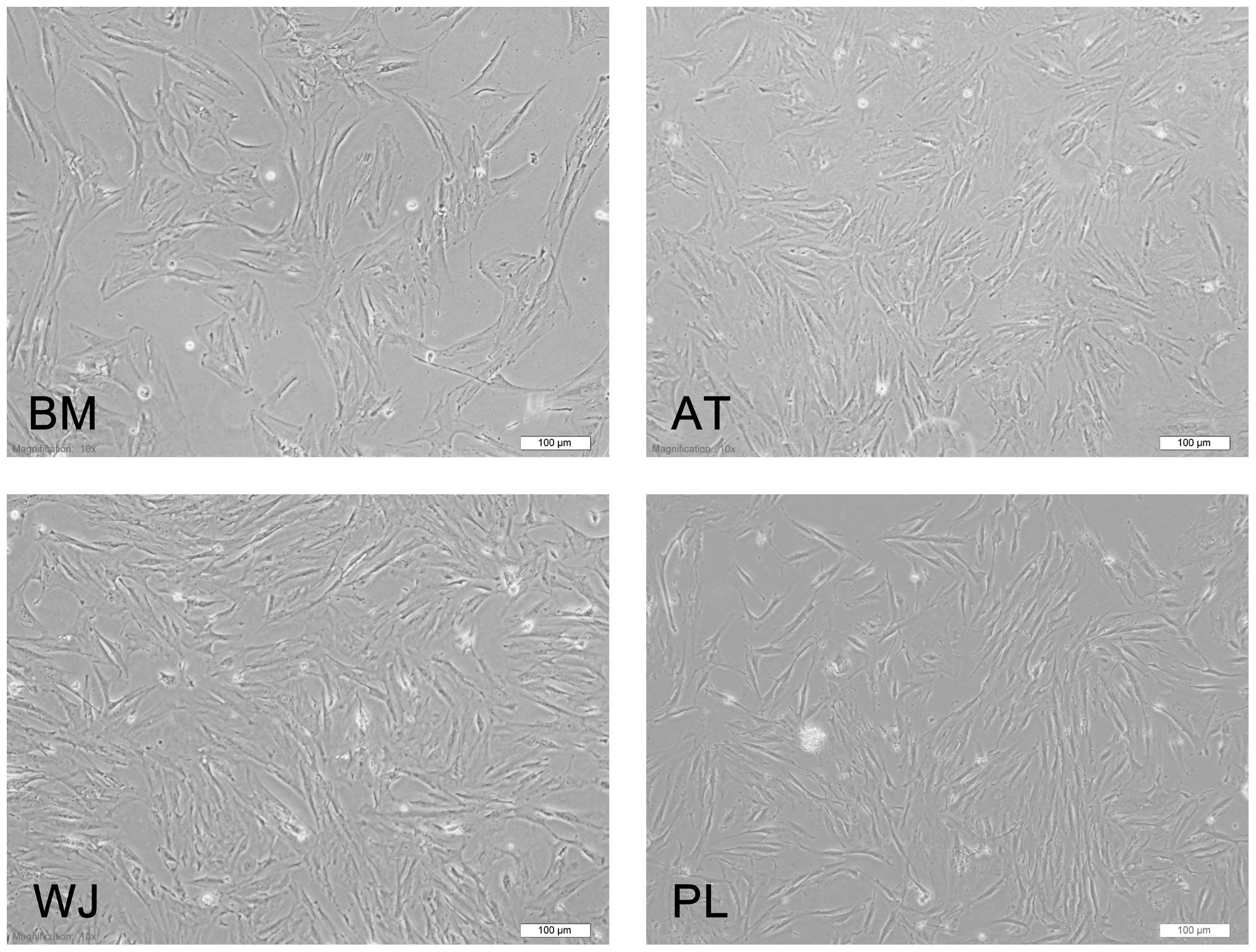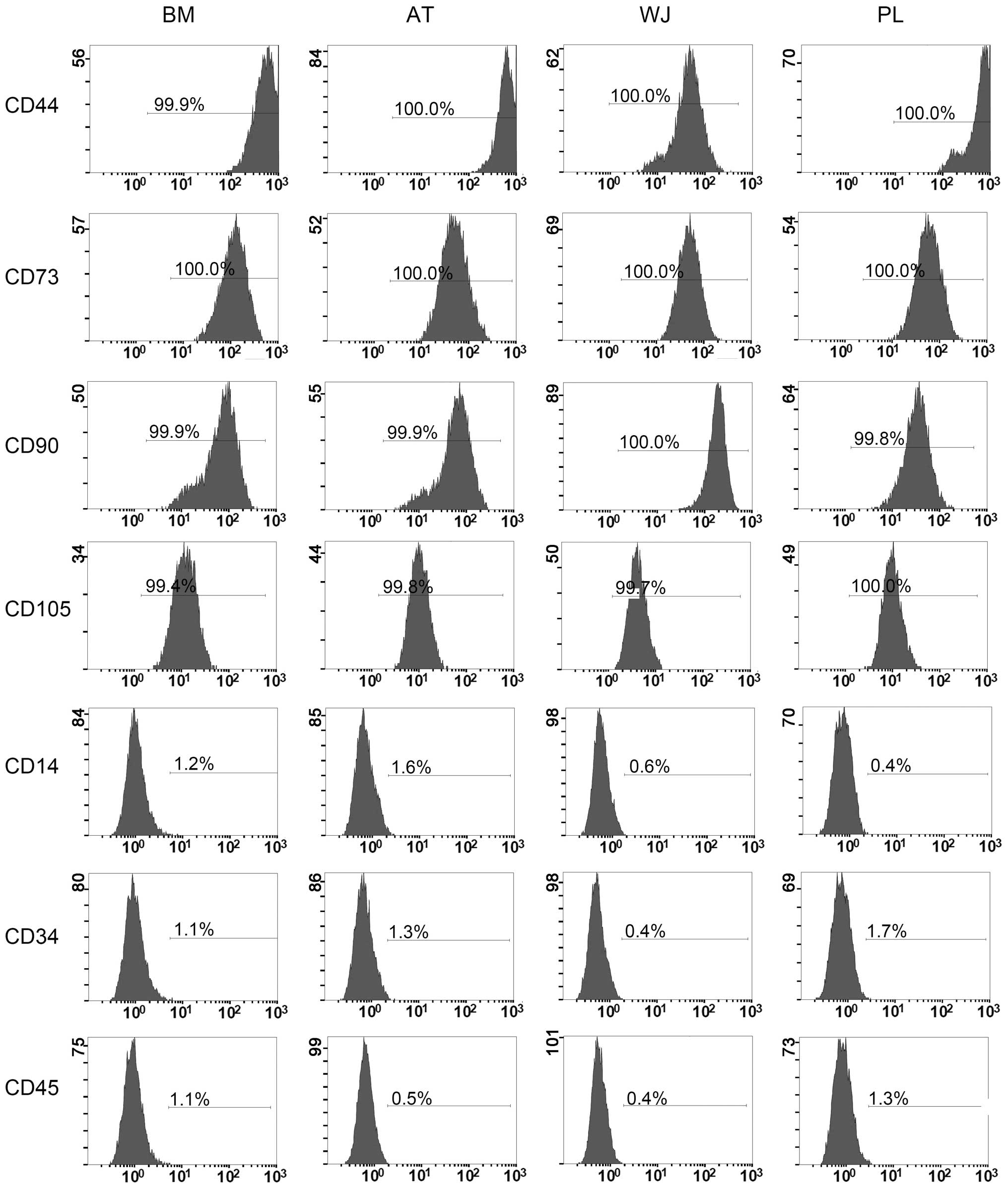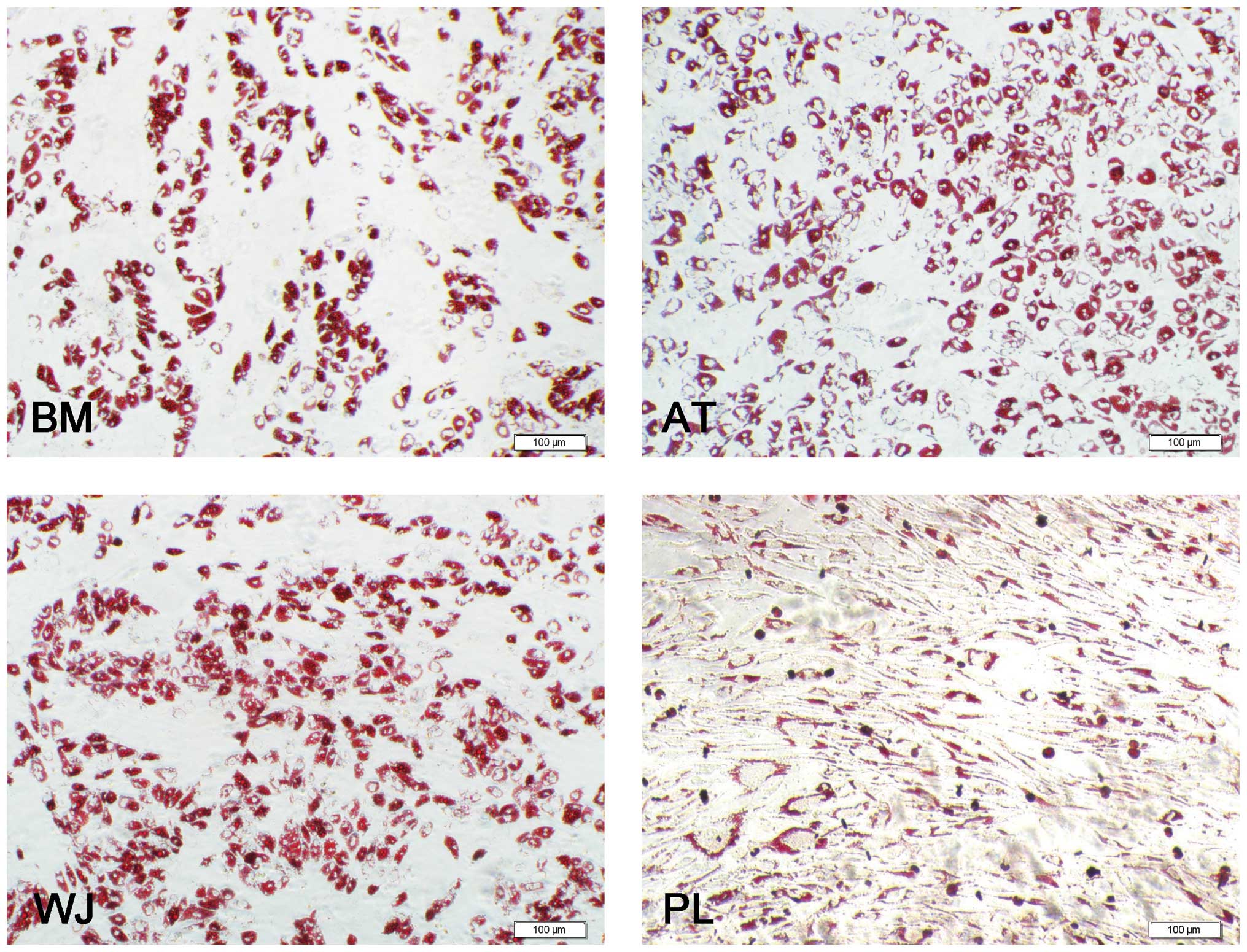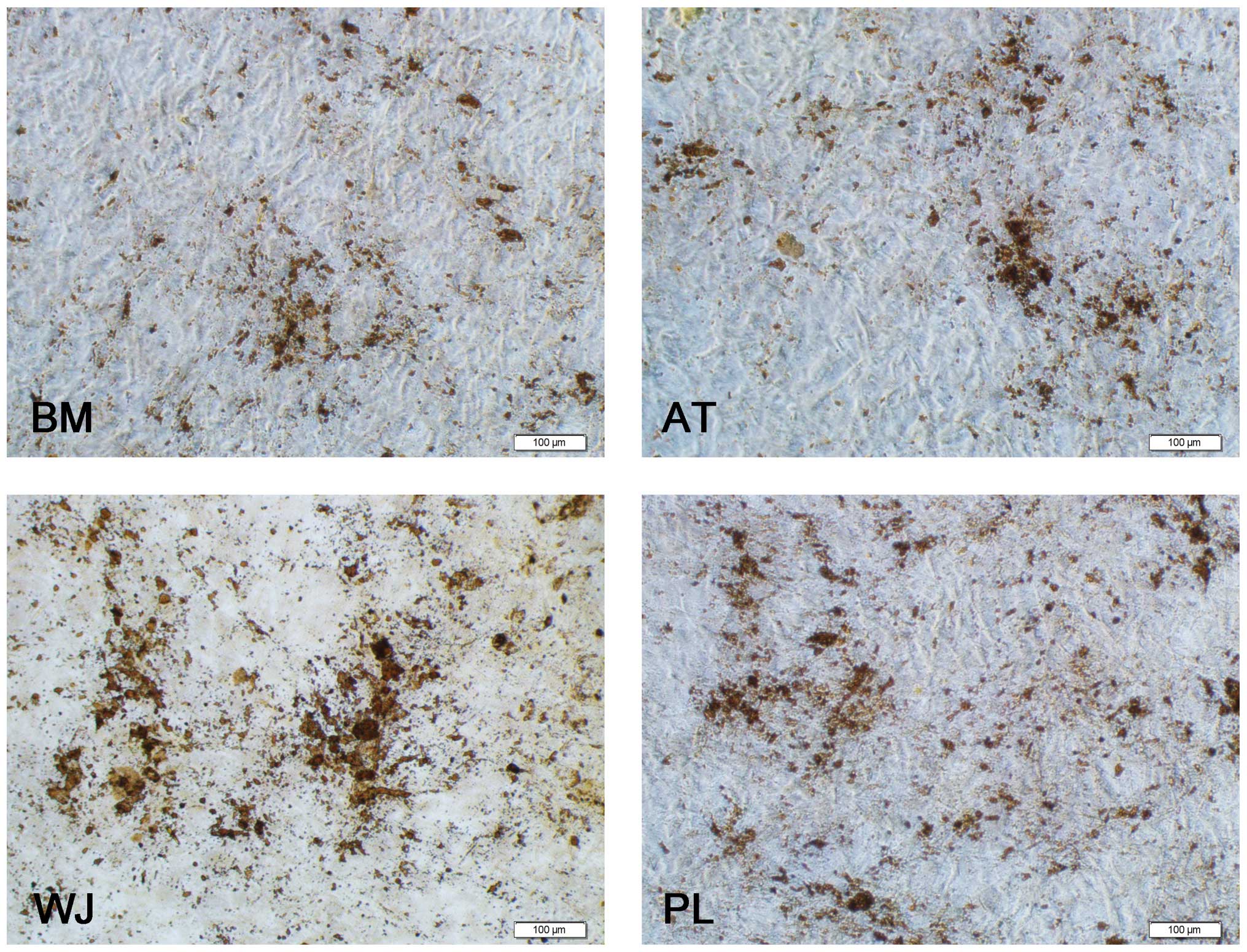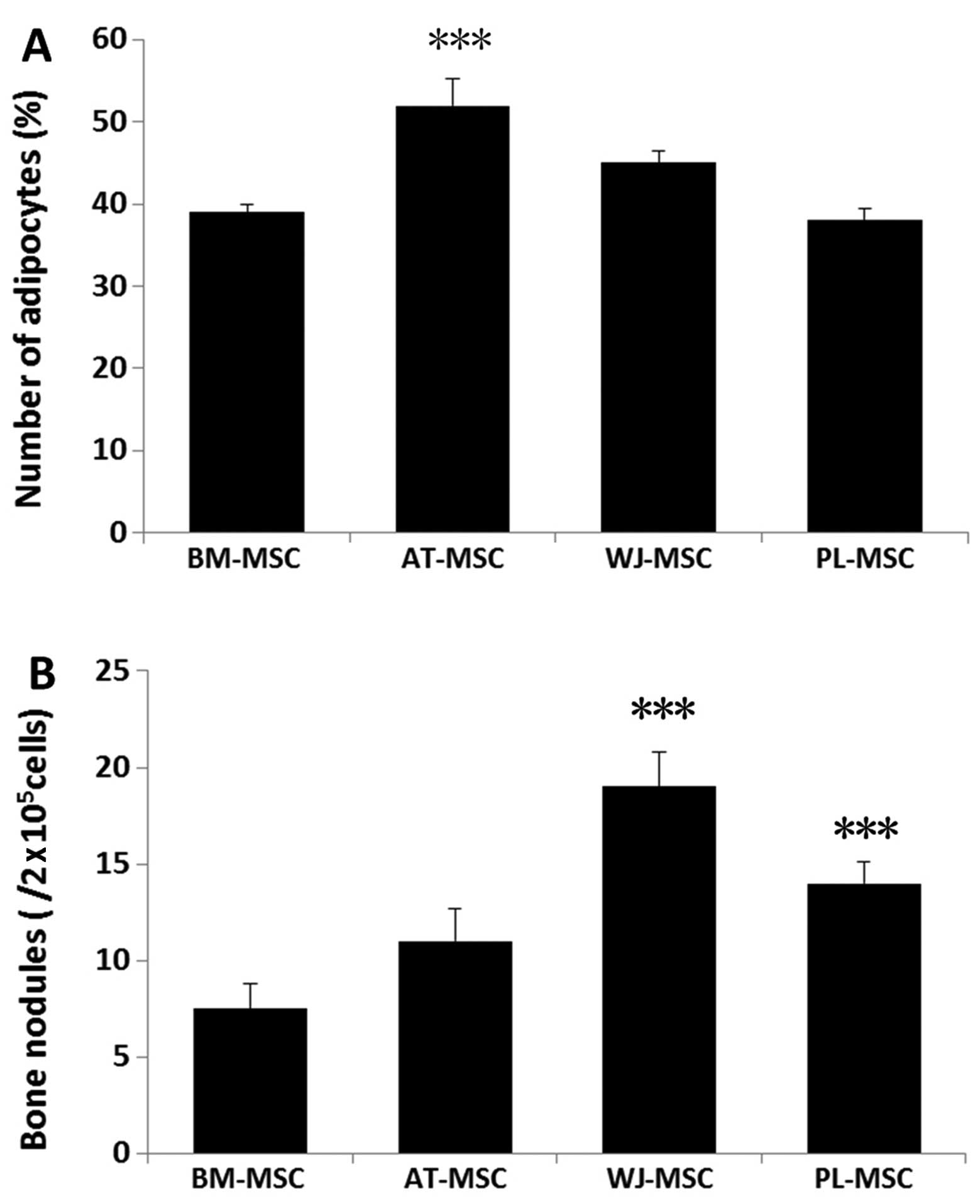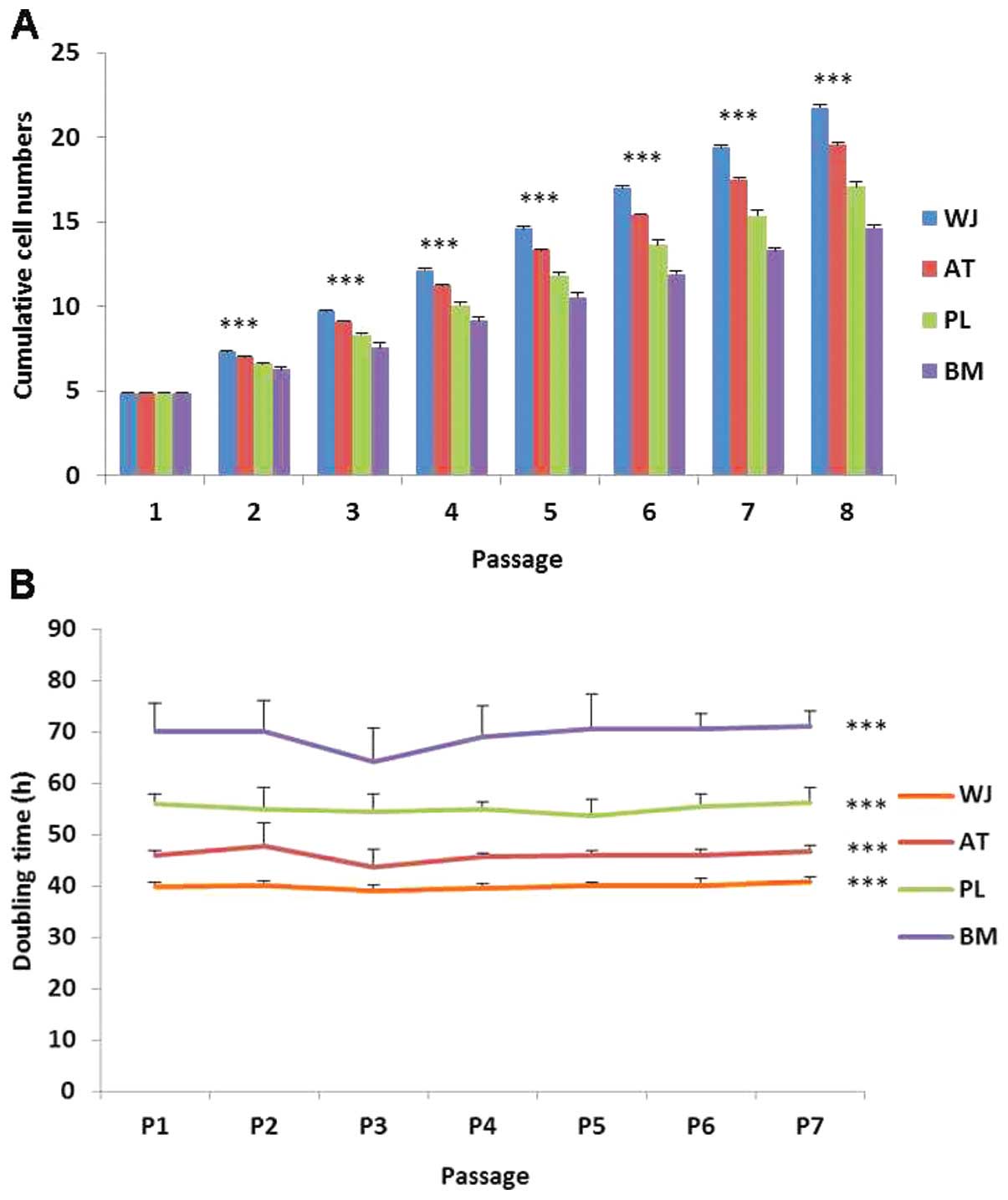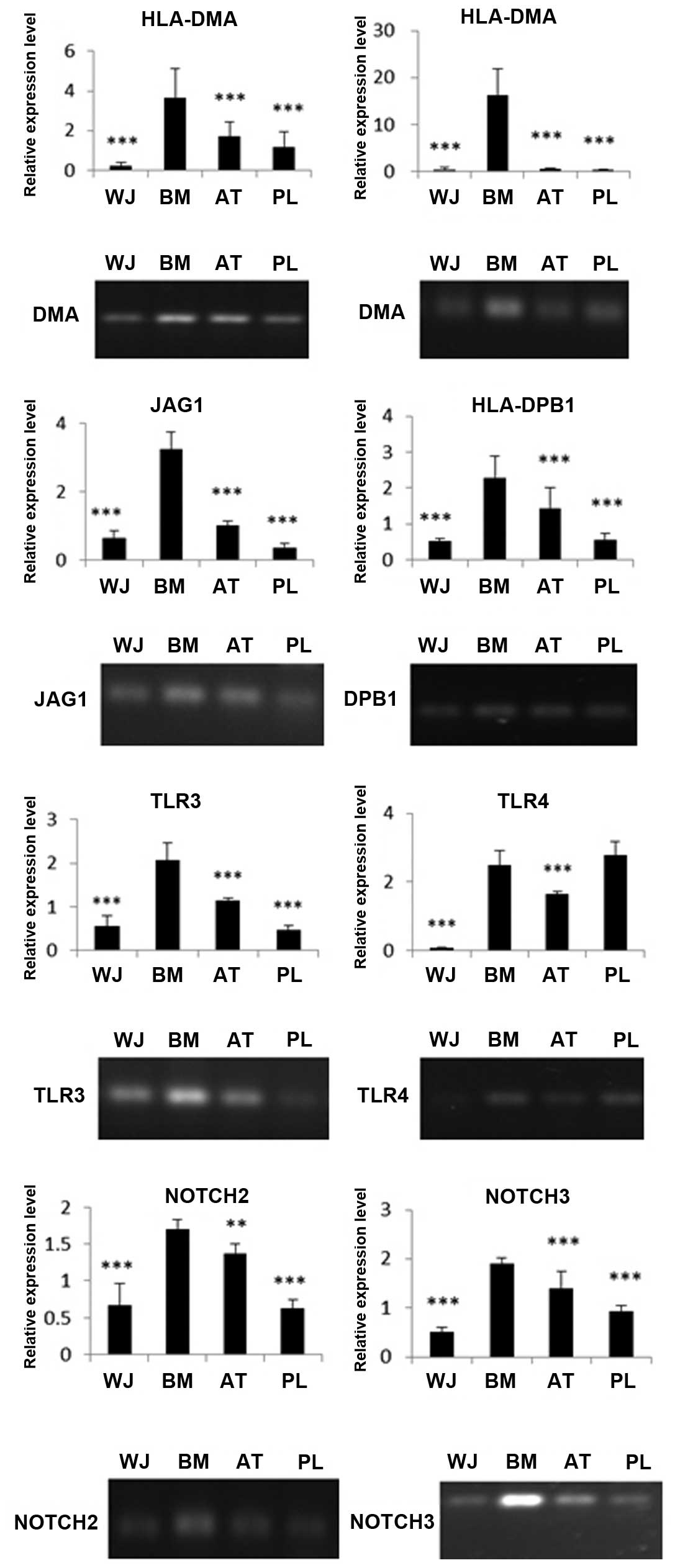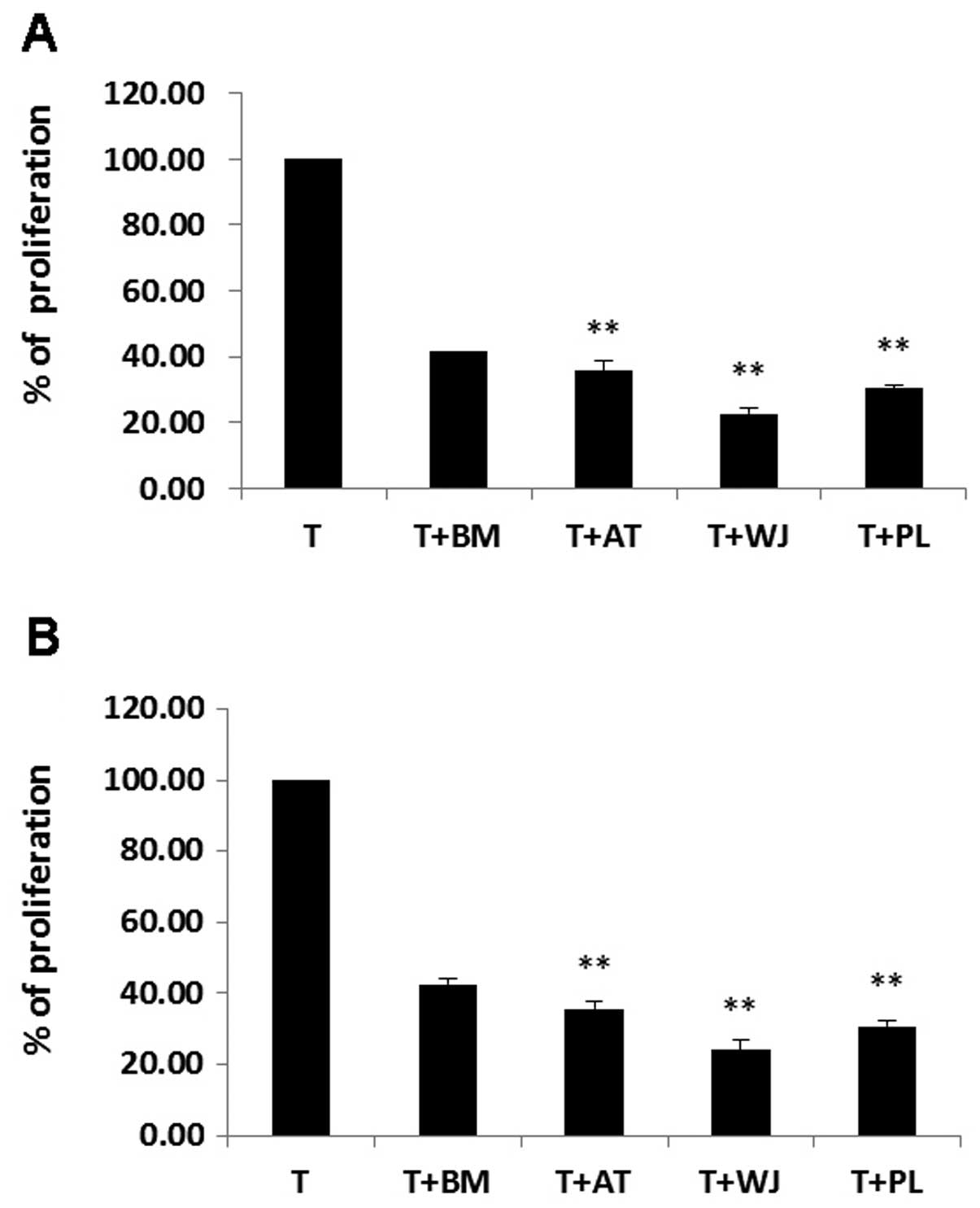|
1
|
Friedenstein AJ, Chailakhyan RK, Latsinik
NV, Panasyuk AF and Keiliss-Borok IV: Stromal cells responsible for
transferring the microenvironment of the hemopoietic tissues.
Cloning in vitro and retransplantation in vivo. Transplantation.
17:331–340. 1974. View Article : Google Scholar : PubMed/NCBI
|
|
2
|
Caplan AI: Mesenchymal stem cells. J
Orthop Res. 9:641–650. 1991. View Article : Google Scholar : PubMed/NCBI
|
|
3
|
Kopen GC, Prockop DJ and Phinney DG:
Marrow stromal cells migrate throughout forebrain and cerebellum,
and they differentiate into astrocytes after injection into
neonatal mouse brains. Proc Natl Acad Sci USA. 96:10711–10716.
1999. View Article : Google Scholar
|
|
4
|
Pittenger MF, Mackay AM, Beck SC, et al:
Multilineage potential of adult human mesenchymal stem cells.
Science. 284:143–147. 1999. View Article : Google Scholar : PubMed/NCBI
|
|
5
|
Beltrami AP, Cesselli D, Bergamin N, et
al: Multipotent cells can be generated in vitro from several adult
human organs (heart, liver, and bone marrow). Blood. 110:3438–3446.
2007. View Article : Google Scholar : PubMed/NCBI
|
|
6
|
Fan CG, Zhang QJ and Zhou JR: Therapeutic
potentials of mesenchymal stem cells derived from human umbilical
cord. Stem Cell Rev. 7:195–207. 2011. View Article : Google Scholar : PubMed/NCBI
|
|
7
|
Mosna F, Sensebe L and Krampera M: Human
bone marrow and adipose tissue mesenchymal stem cells: a user’s
guide. Stem Cells Dev. 19:1449–1470. 2010.
|
|
8
|
Friedenstein AJ, Petrakova KV, Kurolesova
AI and Frolova GP: Heterotopic of bone marrow. Analysis of
precursor cells for osteogenic and hematopoietic tissues.
Transplantation. 6:230–247. 1968.PubMed/NCBI
|
|
9
|
Tondreau T, Meuleman N, Delforge A, et al:
Mesenchymal stem cells derived from CD133-positive cells in
mobilized peripheral blood and cord blood: proliferation, Oct4
expression, and plasticity. Stem Cells. 23:1105–1112. 2005.
View Article : Google Scholar : PubMed/NCBI
|
|
10
|
Zuk PA, Zhu M, Mizuno H, et al:
Multilineage cells from human adipose tissue: implications for
cell-based therapies. Tissue Eng. 7:211–228. 2001. View Article : Google Scholar : PubMed/NCBI
|
|
11
|
Campagnoli C, Roberts IA, Kumar S, Bennett
PR, Bellantuono I and Fisk NM: Identification of mesenchymal
stem/progenitor cells in human first-trimester fetal blood, liver,
and bone marrow. Blood. 98:2396–2402. 2001. View Article : Google Scholar : PubMed/NCBI
|
|
12
|
Keating A: Mesenchymal stromal cells. Curr
Opin Hematol. 13:419–425. 2006. View Article : Google Scholar
|
|
13
|
Friedenstein AJ, Chailakhjan RK and
Lalykina KS: The development of fibroblast colonies in monolayer
cultures of guinea-pig bone marrow and spleen cells. Cell Tissue
Kinet. 3:393–403. 1970.PubMed/NCBI
|
|
14
|
Friedenstein AJ, Gorskaja JF and Kulagina
NN: Fibroblast precursors in normal and irradiated mouse
hematopoietic organs. Exp Hematol. 4:267–274. 1976.PubMed/NCBI
|
|
15
|
Grassel S, Stockl S and Jenei-Lanzl Z:
Isolation, culture, and osteogenic/chondrogenic differentiation of
bone marrow-derived mesenchymal stem cells. Methods Mol Biol.
879:203–267. 2012. View Article : Google Scholar : PubMed/NCBI
|
|
16
|
Eslaminejad MB, Mirzadeh H, Mohamadi Y and
Nickmahzar A: Bone differentiation of marrow-derived mesenchymal
stem cells using beta-tricalcium phosphate-alginate-gelatin hybrid
scaffolds. J Tissue Eng Regen Med. 1:417–424. 2007. View Article : Google Scholar : PubMed/NCBI
|
|
17
|
Reyes M, Lund T, Lenvik T, Aguiar D,
Koodie L and Verfaillie CM: Purification and ex vivo expansion of
postnatal human marrow mesodermal progenitor cells. Blood.
98:2615–2625. 2001. View Article : Google Scholar
|
|
18
|
Tomic S, Djokic J, Vasilijic S, et al:
Immunomodulatory properties of mesenchymal stem cells derived from
dental pulp and dental follicle are susceptible to activation by
toll-like receptor agonists. Stem Cells Dev. 20:695–708. 2011.
View Article : Google Scholar : PubMed/NCBI
|
|
19
|
Toubai T, Paczesny S, Shono Y, et al:
Mesenchymal stem cells for treatment and prevention of
graft-versus-host disease after allogeneic hematopoietic cell
transplantation. Curr Stem Cell Res Ther. 4:252–259. 2009.
View Article : Google Scholar : PubMed/NCBI
|
|
20
|
Tse WT, Pendleton JD, Beyer WM, Egalka MC
and Guinan EC: Suppression of allogeneic T-cell proliferation by
human marrow stromal cells: implications in transplantation.
Transplantation. 75:389–397. 2003. View Article : Google Scholar : PubMed/NCBI
|
|
21
|
Ramasamy R, Tong CK, Seow HF, Vidyadaran S
and Dazzi F: The immunosuppressive effects of human bone
marrow-derived mesenchymal stem cells target T cell proliferation
but not its effector function. Cell Immunol. 251:131–136. 2008.
View Article : Google Scholar : PubMed/NCBI
|
|
22
|
Che N, Li X, Zhou S, et al: Umbilical cord
mesenchymal stem cells suppress B-cell proliferation and
differentiation. Cell Immunol. 274:46–53. 2012. View Article : Google Scholar : PubMed/NCBI
|
|
23
|
Spaggiari GM, Capobianco A, Becchetti S,
Mingari MC and Moretta L: Mesenchymal stem cell-natural killer cell
interactions: evidence that activated NK cells are capable of
killing MSCs, whereas MSCs can inhibit IL-2-induced NK-cell
proliferation. Blood. 107:1484–1490. 2006. View Article : Google Scholar : PubMed/NCBI
|
|
24
|
Deuse T, Stubbendorff M, Tang-Quan K, et
al: Immunogenicity and immunomodulatory properties of umbilical
cord lining mesenchymal stem cells. Cell Transplant. 20:655–667.
2011. View Article : Google Scholar : PubMed/NCBI
|
|
25
|
Najar M, Raicevic G, Id Boufker H, et al:
Modulated expression of adhesion molecules and galectin-1: role
during mesenchymal stromal cell immunoregulatory functions. Exp
Hematol. 38:922–932. 2010. View Article : Google Scholar : PubMed/NCBI
|
|
26
|
De Bruyn C, Najar M, Raicevic G, et al: A
rapid, simple, and reproducible method for the isolation of
mesenchymal stromal cells from Wharton’s jelly without enzymatic
treatment. Stem Cells Dev. 20:547–557. 2011.
|
|
27
|
Battula VL, Bareiss PM, Treml S, et al:
Human placenta and bone marrow derived MSC cultured in serum-free,
b-FGF-containing medium express cell surface frizzled-9 and SSEA-4
and give rise to multilineage differentiation. Differentiation.
75:279–291. 2007. View Article : Google Scholar : PubMed/NCBI
|
|
28
|
Livak KJ and Schmittgen TD: Analysis of
relative gene expression data using real-time quantitative PCR and
the 2(-Delta Delta C(T)) method. Methods. 25:402–408. 2001.
View Article : Google Scholar : PubMed/NCBI
|
|
29
|
Young RG, Butler DL, Weber W, Caplan AI,
Gordon SL and Fink DJ: Use of mesenchymal stem cells in a collagen
matrix for Achilles tendon repair. J Orthop Res. 16:406–413. 1998.
View Article : Google Scholar : PubMed/NCBI
|
|
30
|
Wakitani S, Saito T and Caplan AI:
Myogenic cells derived from rat bone marrow mesenchymal stem cells
exposed to 5-azacytidine. Muscle Nerve. 18:1417–1426. 1995.
View Article : Google Scholar : PubMed/NCBI
|
|
31
|
Parker AM and Katz AJ: Adipose-derived
stem cells for the regeneration of damaged tissues. Expert Opin
Biol Ther. 6:567–578. 2006. View Article : Google Scholar : PubMed/NCBI
|
|
32
|
Kobayashi K, Kubota T and Aso T: Study on
myofibroblast differentiation in the stromal cells of Wharton’s
jelly: expression and localization of alpha-smooth muscle actin.
Early Hum Dev. 51:223–233. 1998.PubMed/NCBI
|
|
33
|
Wulf GG, Viereck V, Hemmerlein B, et al:
Mesengenic progenitor cells derived from human placenta. Tissue
Eng. 10:1136–1147. 2004. View Article : Google Scholar : PubMed/NCBI
|
|
34
|
Chen MY, Lie PC, Li ZL and Wei X:
Endothelial differentiation of Wharton’s jelly-derived mesenchymal
stem cells in comparison with bone marrow-derived mesenchymal stem
cells. Exp Hematol. 37:629–640. 2009.
|
|
35
|
Baksh D, Yao R and Tuan RS: Comparison of
proliferative and multilineage differentiation potential of human
mesenchymal stem cells derived from umbilical cord and bone marrow.
Stem Cells. 25:1384–1392. 2007. View Article : Google Scholar : PubMed/NCBI
|
|
36
|
Raynaud CM, Maleki M, Lis R, et al:
Comprehensive characterization of mesenchymal stem cells from human
placenta and fetal membrane and their response to osteoactivin
stimulation. Stem Cells Int. 2012:6583562012. View Article : Google Scholar : PubMed/NCBI
|
|
37
|
Zhu SF, Zhong ZN, Fu XF, et al: Comparison
of cell proliferation, apoptosis, cellular morphology and
ultrastructure between human umbilical cord and placenta-derived
mesenchymal stem cells. Neurosci Lett. 541:77–82. 2013. View Article : Google Scholar
|
|
38
|
Stenderup K, Justesen J, Clausen C and
Kassem M: Aging is associated with decreased maximal life span and
accelerated senescence of bone marrow stromal cells. Bone.
33:919–926. 2003. View Article : Google Scholar : PubMed/NCBI
|
|
39
|
Post S, Abdallah BM, Bentzon JF and Kassem
M: Demonstration of the presence of independent pre-osteoblastic
and pre-adipocytic cell populations in bone marrow-derived
mesenchymal stem cells. Bone. 43:32–39. 2008. View Article : Google Scholar : PubMed/NCBI
|
|
40
|
Larsen KH, Frederiksen CM, Burns JS,
Abdallah BM and Kassem M: Identifying a molecular phenotype for
bone marrow stromal cells with in vivo bone-forming capacity. J
Bone Miner Res. 25:796–808. 2010.PubMed/NCBI
|
|
41
|
De Ugarte DA, Morizono K, Elbarbary A, et
al: Comparison of multi-lineage cells from human adipose tissue and
bone marrow. Cells Tissues Organs. 174:101–109. 2003.PubMed/NCBI
|
|
42
|
Lorenz K, Sicker M, Schmelzer E, et al:
Multilineage differentiation potential of human dermal skin-derived
fibroblasts. Exp Dermatol. 17:925–932. 2008. View Article : Google Scholar : PubMed/NCBI
|
|
43
|
Kern S, Eichler H, Stoeve J, Kluter H and
Bieback K: Comparative analysis of mesenchymal stem cells from bone
marrow, umbilical cord blood, or adipose tissue. Stem Cells.
24:1294–1301. 2006. View Article : Google Scholar
|
|
44
|
Zhang X, Hirai M, Cantero S, et al:
Isolation and characterization of mesenchymal stem cells from human
umbilical cord blood: reevaluation of critical factors for
successful isolation and high ability to proliferate and
differentiate to chondrocytes as compared to mesenchymal stem cells
from bone marrow and adipose tissue. J Cell Biochem. 112:1206–1218.
2011.
|
|
45
|
Dazzi F and Krampera M: Mesenchymal stem
cells and autoimmune diseases. Best Pract Res Clin Haematol.
24:49–57. 2011. View Article : Google Scholar
|
|
46
|
Kebriaei P and Robinson S: Treatment of
graft-versus-host-disease with mesenchymal stromal cells.
Cytotherapy. 13:262–268. 2011. View Article : Google Scholar : PubMed/NCBI
|
|
47
|
Kode JA, Mukherjee S, Joglekar MV and
Hardikar AA: Mesenchymal stem cells: immunobiology and role in
immunomodulation and tissue regeneration. Cytotherapy. 11:377–391.
2009. View Article : Google Scholar : PubMed/NCBI
|
|
48
|
Krampera M, Glennie S, Dyson J, et al:
Bone marrow mesenchymal stem cells inhibit the response of naive
and memory antigen-specific T cells to their cognate peptide.
Blood. 101:3722–3729. 2003. View Article : Google Scholar
|
|
49
|
Polchert D, Sobinsky J, Douglas G, et al:
IFN-gamma activation of mesenchymal stem cells for treatment and
prevention of graft versus host disease. Eur J Immunol.
38:1745–1755. 2008. View Article : Google Scholar : PubMed/NCBI
|
|
50
|
Rubinstein P, Rosenfield RE, Adamson JW
and Stevens CE: Stored placental blood for unrelated bone marrow
reconstitution. Blood. 81:1679–1690. 1993.PubMed/NCBI
|
|
51
|
Augello A, Tasso R, Negrini SM, et al:
Bone marrow mesenchymal progenitor cells inhibit lymphocyte
proliferation by activation of the programmed death 1 pathway. Eur
J Immunol. 35:1482–1490. 2005. View Article : Google Scholar : PubMed/NCBI
|
|
52
|
Yang SH, Park MJ, Yoon IH, et al: Soluble
mediators from mesenchymal stem cells suppress T cell proliferation
by inducing IL-10. Exp Mol Med. 41:315–324. 2009. View Article : Google Scholar : PubMed/NCBI
|



